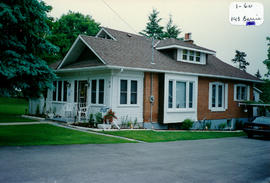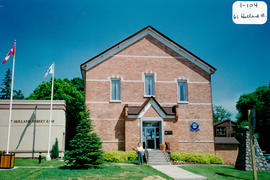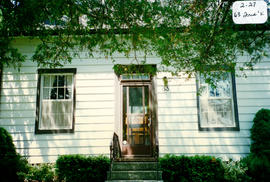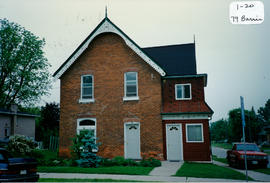The Bradford Town Hall is located at 61 Holland St. East. It survived the fire of 1871 that destroyed much of Bradford’s downtown. The building was being used as a schoolhouse in 1875 when a severe wind storm blew off the roof and killed a member of the Woods’ family. Reports disagree about the number of school children injured. Bricks were salvaged from damaged sections of the building and reused in the construction of a duplex at 31/33 Bingham Street. The building was a market place for farmers until the mid 1930’s. There was a commons at the rear for pasturing. It later became a playground. There were stalls and display tables for farm animals, chickens etc. Jim Nesbitt was one of the managers. Upstairs was a hall with a raised stage and raised steps at the front. Readings, lectures, visiting theatre groups, dances, minstrel shows and meetings with dignitaries were all held here. Buster Matthews had a casket-manufacturing business in the basement for a while. Charlie Heath held movies here. Later there was a badminton court.
The structure was overhauled after WWII. The ceiling was lowered, beautiful light fixtures were converted to hydro and refurbished, and the stage was removed. All records and centennial books were destroyed and it was turned into a court house. The west stairs were closed off and the raised steps removed. The building was originally heated by a large wood-burning furnace in the basement before it was converted to oil. It was originally lighted with manufactured gas and then hydro after 1916. The old chandeliers still remain. Bradford’s first police force was located in this building for several years. The town’s administrative business was also conducted from here. On the west side of the Town Hall there once was a three-bay fire hall. At the back there was a Recreation Hall with a kitchen and toilets for the volunteer firemen to use. It was rented by the Lions Club (who met here for a number of years). The firemen provided draws and suppers to raise money for new equipment (a lot of which they manufactured themselves). It was heated by natural gas and built by Irma (?) and the walls were thick enough for a second storey. There is a stone cairn with a plaque in memory of Professor W.H. Day on the east side of the sidewalk. The WWI veterans built a cairn where the fire hall was. A cannon and a plaque with the names of those who perished in Europe were also there.
The current, two-storey Town Hall was built in the 1830-1860’s in the Classic Revival style. It has a symmetrical façade with a simplified, temple form and a medium-pitched, ‘pediment’ gable roof with plain cornice and frieze supported on brackets. There is an enclosed, raised porch with a steeply-pitched, centre gable (reminiscent of Gothic Revival). It is set into a shed roof flanked by corbelled parapets at each side and a plain cornice and frieze supported on brackets. The entrance door, stairs, and railing are not original. The entrance opening had been modified, but the original dichromatic brick that highlighted the top of the original entrance opening is still visible on either side of the new opening. There are tall window openings with high floor to ceiling heights. The windows are set into segmented, arch openings ornamented with alternating voussoirs and ‘ears’ of dichromatic brick and stone (or concrete) lug sills. The centre window above the entrance is raised above the entrance gable and ties together the entrance projection and façade composition behind. Original windows were probably double-hung and multi-paned. The ground-floor windows have been blocked in, but their outline is still visible on the front façade. There is a horizontal, dichromatic brick string coursing. The structure has masonry construction with brick cladding (sandblasted) and a random, rubble-stone foundation. An original, open-frame cupola/bell tower with a steeply-pitched, bell-cast roof and chimneys were missing when the building was inventoried in 2000. At that time the building was considered to be in good condition. (1, 2, 3, 4)










